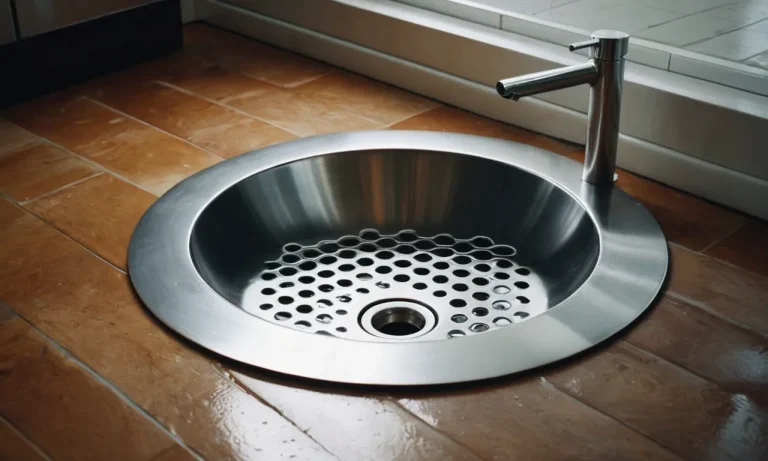Bar Faucet Vs Kitchen Faucet: Which Is Better For Your Home?
If you’re remodeling your kitchen or building a home bar, one of the many decisions you’ll have to make is choosing the right faucet. Kitchen and bar faucets may seem interchangeable, but there are some key differences you’ll want to consider before making your purchase.
If you’re short on time, here’s a quick answer: Bar faucets are designed for filling glasses and cleaning drinkware, while kitchen faucets are made for food prep, cleanup, and other sink tasks. Bar faucets have a higher spout for clearing glasses and aerated flow for fast fill-ups.
Kitchen faucets offer more features like pull-down sprayers and are more ergonomic for handwashing and dish cleaning.
In this comprehensive guide, we’ll go over the differences between bar and kitchen faucets including height, flow rate, features, installation, and aesthetics. We’ll help you determine which is better suited for your needs so you can pick the perfect faucet for your home.
Bar Faucet Features and Benefits
High spout height
A key feature of bar faucets is their high spout height. Unlike kitchen faucets which are typically designed for regular sink use, bar faucets have a taller spout that allows for easier filling of taller containers such as pitchers or large pots.
This feature is especially convenient when you need to quickly fill up a pitcher of water for a party or boil a large pot of pasta for a family gathering.
Faster water flow rate
Another advantage of bar faucets is their faster water flow rate. With a higher flow rate than traditional kitchen faucets, bar faucets can quickly fill up containers or rinse dishes with ease. This can save you valuable time in the kitchen and make your cooking and cleaning tasks more efficient.
Simpler design
Bar faucets are known for their sleek and minimalist design. Unlike kitchen faucets which often come with additional features such as sprayers or pull-out spouts, bar faucets have a simpler and more compact design. This makes them perfect for smaller sinks or bar areas where space may be limited.
Additionally, the simpler design of bar faucets can also complement a variety of kitchen styles and aesthetics.
For more information on bar faucets and their features, you can visit websites such as Home Depot or Lowe’s for a wide range of options and expert advice.
Kitchen Faucet Features and Benefits
Lower spout height
One of the key features of a kitchen faucet is its lower spout height. Unlike bar faucets, which typically have a higher spout to accommodate taller glasses and bottles, kitchen faucets have a lower spout height that is more suitable for everyday tasks in the kitchen.
This lower spout height makes it easier to fill pots and pans, wash dishes, and rinse fruits and vegetables without splashing water all over the countertop.
Slower laminar flow
Another benefit of a kitchen faucet is its slower laminar flow. Laminar flow refers to a steady stream of water without any splashing or turbulence. This type of flow is particularly useful when you need precise control over the water flow, such as when filling a delicate glass or rinsing fragile items.
The slower laminar flow of a kitchen faucet ensures that the water comes out in a controlled manner, reducing the chances of accidental spills or breakages.
More features like sprayers
When it comes to features, kitchen faucets often offer more options compared to bar faucets. Many kitchen faucets come with integrated sprayers, which can be pulled out or pulled down to extend the reach of the water flow.
This is especially handy when washing large pots or cleaning hard-to-reach corners of the sink. Additionally, some kitchen faucets also offer different spray patterns, allowing you to switch between a regular stream and a more powerful spray depending on your needs.
More ergonomic for handwashing and cleaning
Kitchen faucets are designed with ergonomics in mind, making them more comfortable to use for extended periods of handwashing and cleaning. The handles of kitchen faucets are typically larger and easier to grip, providing better control over the water flow and temperature.
This is especially beneficial for those with limited hand mobility or arthritis. Moreover, kitchen faucets often have a longer spout reach, allowing you to easily maneuver larger items under the stream of water for efficient cleaning.
Aesthetic Differences
Bar faucets designed for visual appeal
When it comes to aesthetics, bar faucets are often designed to make a statement. These faucets are typically smaller in size compared to kitchen faucets, allowing them to fit seamlessly into a variety of bar or prep sink setups.
They come in a wide range of styles, finishes, and designs, allowing homeowners to choose one that matches their overall kitchen or bar aesthetic. From sleek modern designs to classic and traditional styles, bar faucets offer plenty of options to enhance the visual appeal of your home.
Kitchen faucets blend form and function
Kitchen faucets, on the other hand, are designed to not only look good but also provide functionality. They are larger and more robust than bar faucets, as they are meant to handle the daily demands of a kitchen.
Kitchen faucets often come with additional features such as pull-out sprayers, multiple spray settings, and even touchless technology for added convenience. These faucets are available in various finishes and styles, allowing homeowners to find one that complements their kitchen decor while still offering the functionality required for daily cooking and cleaning tasks.
It’s important to note that while bar faucets prioritize visual appeal, they can still offer some degree of functionality. Similarly, kitchen faucets can also be aesthetically pleasing. The decision between a bar faucet and a kitchen faucet ultimately depends on your specific needs and preferences.
Installation Considerations
Bar faucets usually single-hole mount
When considering the installation of a bar faucet, it is important to note that these types of faucets typically require a single-hole mount. This means that they are designed to be installed in a single pre-drilled hole in the countertop or sink.
The advantage of this type of installation is that it provides a clean and streamlined look, making it a popular choice for smaller spaces or areas where aesthetics are important.
Kitchen faucets offer more mounting options
In contrast, kitchen faucets generally offer more mounting options compared to bar faucets. They can be installed in a single-hole mount, but they also often come with additional options such as a three-hole mount or a wall-mount installation.
This versatility allows for more flexibility when it comes to choosing the right faucet for your kitchen. If you have an existing sink or countertop with multiple holes, a kitchen faucet with a three-hole mount can easily be accommodated.
Deck thickness is important
When installing either a bar faucet or a kitchen faucet, it is crucial to consider the thickness of the deck or countertop. The deck thickness refers to the distance between the surface of the countertop or sink and the underside of the faucet.
This measurement is important because it determines the compatibility of the faucet with your sink or countertop.
For bar faucets, the deck thickness is typically thinner compared to kitchen faucets. This is due to the fact that bar sinks are usually smaller and may not have as much material between the surface and the plumbing.
It is essential to measure the deck thickness accurately before purchasing a faucet to ensure a proper fit.
On the other hand, kitchen faucets are designed to accommodate a wider range of deck thicknesses. This is because kitchen sinks and countertops can vary significantly in thickness. Manufacturers often provide adjustable mounting hardware or extension kits to accommodate different deck thicknesses, making it easier to find a compatible faucet for your kitchen.
Remember to consult the manufacturer’s specifications and guidelines for installation to ensure a smooth and successful installation process. If in doubt, it is always recommended to seek the assistance of a professional plumber.
Helpful Tips for Choosing
When it comes to selecting between a bar faucet and a kitchen faucet, there are a few key factors to consider. By keeping these helpful tips in mind, you can make an informed decision that suits your needs and enhances the functionality of your home.
Consider primary use
The first step in choosing between a bar faucet and a kitchen faucet is to consider the primary use of the faucet. A bar faucet is typically smaller and more compact, making it ideal for use in a wet bar or secondary sink.
On the other hand, a kitchen faucet is designed for heavy-duty use in the main kitchen sink. Think about how you plan to use the faucet and choose accordingly.
Measure your space
Before making a decision, it’s important to measure the space where the faucet will be installed. Ensure that the faucet you choose fits the dimensions of your sink or countertop. Taking accurate measurements will help you avoid any installation issues or inconvenience down the line.
Pick appropriate features
Consider the features you want in a faucet. Both bar faucets and kitchen faucets come with a variety of options such as pull-down sprayers, touchless operation, and adjustable water flow. Determine which features are important to you and make sure the faucet you choose offers them.
This will ensure that you have a faucet that meets your specific needs.
Mind the theme
Lastly, consider the overall theme and design of your kitchen or wet bar. Choose a faucet that complements the aesthetic of your space. Whether you prefer a sleek and modern look or a more traditional style, there are numerous options available to match your taste.
Taking the time to find a faucet that blends seamlessly with your existing décor will enhance the overall appeal of your home.
By considering the primary use, measuring your space, picking appropriate features, and minding the theme, you can confidently choose between a bar faucet and a kitchen faucet. Remember, it’s important to select a faucet that not only meets your functional needs but also adds to the overall aesthetics of your home.
Conclusion
When choosing between a bar faucet and kitchen faucet, it’s important to consider the primary use, available space, desired features, and visual appeal. Bar faucets excel at quickly filling drinkware with their high spouts and fast water flow.
Kitchen faucets are better equipped for food prep and cleanup tasks with pull-down sprayers, soap dispensers, and ergonomic designs.
Measure your existing sink or bartop and determine what kind of functionality you need from your faucet. While there is some overlap, bar and kitchen faucets are designed with different goals in mind. Keeping your main needs and aesthetic in mind will ensure you select the right faucet for your space.







